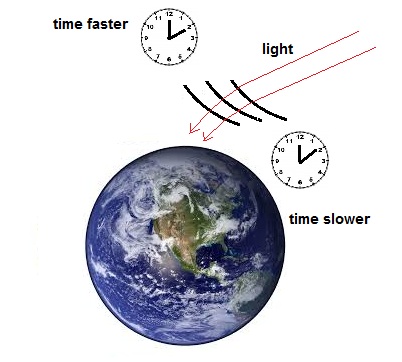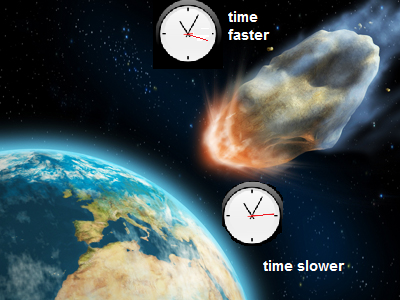If
gravitational
time dilation
is real, why has the earth not torn apart? Doug
Marett, 2013 Introduction: It is
common knowledge that Einstein’s
theory of relativity calls for the passage of time to be a relative
phenomenon
that depends on the perspective of the observer, namely their rate of
motion or
their position in a gravitational gradient. The former phenomenon is
known as
velocity time dilation, and the latter is known as gravitational time
dilation.
The theory actually calls for the rate of real time to be different for
various
observers, such that no such thing as “absolute time” can exist.
Experimental
evidence has shown that atomic clocks will actually speed up as they go
to
higher altitudes, appearing to confirm his predictions. However,
earlier
scientific theories, such as the work of Lorentz, Larmor, and Poincare,
had
suggested that such a phenomenon might occur for far more
mundane reasons,
namely as an illusion due to the finite speed of light and the
dependence of clocks on the same. The question addressed herein is not
whether
clocks count faster or slower in a gravitational gradient, but rather
if the
increase or decrease in the apparent passage of time is an illusion. Einstein’s 1911
Paper: In Einstein’s paper “On the Influence of Gravitation on the Propagation of Light” (1911) he argues that light travelling at an oblique angle bends downward as it approaches the surface of a body like the earth, since time becomes progressively slower as one goes lower in a gravitational potential. The mechanism is as follows:
1) As
light wavefronts approach the surface, the lower edge of the wavefront
slows
down with respect to the upper edge, since time closer to the
gravitational
body is counting slower.
2) This
progressive bending of the wavefront turns the angle of the approaching
light
progressively down.
3) The
speed of light when measured by clocks in their local time is still C,
but if synchronized clocks are used, then the speed of light would
be measured as progressively slower as one approaches the surface.
The
fundamental issues around Einstein’s treatment have already been dealt
with in our previous paper “Light
Propagation in a Gravitational Field.” We want to
focus here on how light behaves with respect to local time. In
order for light to
bend as Einstein claims due to gravitational time dilation, the light
remains in the same "co-relational present” along the
wavefront.
In
other words, no part of the wavefront will advance or recede in local
time in
relation to any other part of the same wavefront.
It is because the entire wavefront
remains in the same co-relational present as it moves that
causes the
bending.
Thus if the wavefront at the top is at 12:10AM local time, it is also
at
12:10AM local time at the bottom.
Why is
this important? Because it helps define how Einstein
interprets time
and the connectivity of objects which are large enough to straddle many
local
time frames. The phenomenon should also apply to moving massive particles as
has been suggested here. If
we extrapolate that matter should be affected
in the same way as light, then we would similarly have to believe that
if a large asteroid
were to enter the earth’s atmosphere, its surface
would bend
to accommodate the difference is the rate of local time between its
upper
and lower surface, since as time counts slower, the velocity
of the
lower edge must travel slower than the upper edge of the interconnected
mass. Velocity = distance/time, so
if the unit of time become longer then the velocity becomes smaller. Of
course
this difference in the rate of time across the asteroid is extremely
small, so
any bending might be imperceptible. The situation is different than
that of a
wavefront since it is impossible for the entire body of the asteroid to
remain
in the same co-relational present if time dilation is in operation. However, a given point x on
the asteroid would
tend to distort from its original shape to preserve the co-relational
progression of the event in local time. This also presents the paradox
that a
single object would then exist partly in the past, present, and future.
bend slightly toward
the earth’s surface due to gravitational
time dilation.
What
if we consider a much larger
object that is bending for a much longer time? The obvious choice would
be the
earth itself. According
to Einstein’s
theory, the surface of the earth where we are standing should
experience a
local time that is heading into the future at a rate somewhat faster
than the
core 6371 km below our feet. Since the earth is a substantially solid
object through
most of its radius (excluding the outer core), it should experience
rigid body
rotation for the majority of its mass. The difference in the rate of
time from
the center to the surface would however imply that the angular
velocity
should actually increase as we approach the surface. So is this
velocity
difference significant? What
would this value
be? The
gravitational time dilation difference from
the surface to the core is t’ = t*(1+ GM/(2Rc^2) ) GM
= 3.9860E14
R = 6371000 (at the equator)
C = ~3 E8 Thus GM/(2Rc^2) = 3.481 E-10 Velocity time dilation = v^2/2c^2 = 465*465/(2*9E16) = 1.2E-12 Sagnac effect = RΩv/c^2 = 2.4E-12 Total time dilation: GM/(2Rc^2)
- v^2/2c^2 - RΩv/c^2 = 3.445 E -10
Thus
a clock at the surface
counts faster than one at the center of the earth by a factor of 1.0000000003445 . Now,
if we take the tangential velocity of the earth’s surface of 465 m/s
(at the
equator), which is moving in rigid body rotation with the rest of the
earth,
and then give it a bending stress forward of this factor, we would find
that
the surface of the earth would pull away from the core rotation at a
rate of: 465
* 1.0000000003445 – 465 = 1.60 E-07
m/s This
amounts to 1.60E-7*3600*24*365 = 5.04 meters per year As
the circumference of the earth is 40,075 km, the crust of the earth
would be expected to progressively pull away from the solid parts of
the earth closer to
the core, and catch up by one full revolution of the earth every 7.9
million
years. That would be about 570 times since the earth’s origin 4.54
billion
years ago! What this should mean is that the earth should progressively
pull
itself apart under the stress of gravitational time dilation. How gravitational time
dilation bending stress should affect the rotating earth.
Further,
the surface should actually rotate faster than the core, an effect that
would
appear to contradict the conservation of energy principle, since time
dilation
would be giving additional acceleration energy to the mass of the
crust. The
additional acceleration of the periphery should drag the core along
with it,
leading to progressively greater and greater amplification of the
surface speed
– large celestial bodies in rotation would then become anti-entropic
free
energy machines until they explode from the rotational stress. This of
course
does not happen, nor do we see any geological striations suggesting the
earth
is twisting under its own rotation, so something must be wrong with
Einstein’s
theory. Pulsars:
If
the time frame of this process on earth seems too long to be
meaningful,
then consider pulsars, very fast, ultra-massive objects in interstellar
space. If
we consider current pulsar models, with a typical radius of 20 km and
a gravitational time
dilation at the surface of 1.000001 that of the core, and rotating at
close to
the speed of light, then the surface of a rotating pulsar should lap
its core
in about 1/5000 of a second (if gravitational time dilation were the
only factor). However, at such high rotational speeds, velocity time
dilation would dominate, leading to a bending in the reverse
direction that would be far stronger but unequal along the
radius.
Seeing
as it is on the density of an atom itself, the exceedingly dense and
solid pulsar should explode pretty
much immediately from the powerful bending stresses from these time dilation factors. Conclusions: What I have attempted to point out here is that if the relativistic notion of time dilation is taken literally, then any massive object moving at a velocity should bend when crossing a gravitational field obliquely, just like a beam of light. Further, a large astronomical object rotating inside of its own gravitational field should also experience a progressive bending and shearing of its outer surface, forcing it to travel at a different angular velocity than its core due to the different rate of time at the surface. Such stresses on these rotating celestial bodies should progressively lead to their flying apart, the rate at which depends only on their size and rotational speed. Such a contradiction with actual experience should lead us to conclude that real time can’t possibly be different at the surface than the core – time dilation must be instead simply a clock error caused by the finite speed of light. |




















